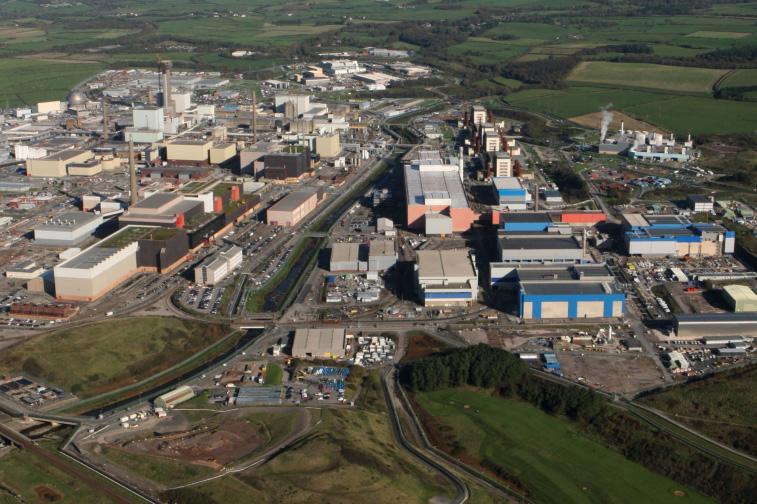“We’re working on a plan to help them monitor for those total dissolved solids to locate any leaks from buried waste.” – Carol Eddy-Dilek

Aerial image of Sellafield Ltd. located in Cumbria, England, a new location where ALTEMIS is being installed. (Sellafield Ltd. Photo)
Research conducted by Savannah River National Laboratory has impacts far beyond the perimeter of the Savannah River Site in Aiken, S.C., where the laboratory has been addressing the nation’s most complex environmental and legacy management challenges for more than 70 years. The Advanced Long-Term Environmental Monitoring Systems Program is an example of innovative technical approach developed by SRNL at SRS and is now being applied in other U.S. locations and internationally to improve groundwater monitoring of long-lived radiological contaminants.
ALTEMIS uses sensors to capture and deliver data that are analyzed using machine learning to predict future contaminant flux by tracking master variables in real time to predict contaminant concentrations and provide early warning of unexpected contaminant plume migration. By measuring the controlling chemical variables (e.g., pH levels, moisture, and other key geochemical changes) that cause contaminants to be released into groundwater, ALTEMIS can predict contaminant movement before it happens.
Since the development and deployment of this innovative strategy at the Savannah River Site’s F-Area, demand for deployment of the technology, in an array of environments, has increased. Each deployment of ALTEMIS beyond the Savannah River Site demonstrates the technology’s ability to drive down monitoring costs and accelerate site closure of groundwater contamination sites. It is estimated that Department Of Energy is currently responsible for $520 billion of the government’s $620 billion (roughly 83 percent) in environmental and disposal liability. ALTEMIS has the potential to reduce the associated long term monitoring costs by an estimated 50 to 80 percent.
Internationally, ALTEMIS is demonstrating its value through projects located in Canada and England.
Project lead Carol Eddy-Dilek said the Canadian Nuclear Laboratories sought ALTEMIS assistance with their strategy for handling a strontium-90 plume at the Chalk River site in Ottawa. Eddy-Dilek said that a beaver dam break sent water toward the plume and diverted the plume away from the existing treatment system and toward the Ottawa River. The monitoring regimen in place at that time led to a significant delay in recognizing the change. At Chalk River the controlling variable is water level, and by monitoring the water level, any changes in groundwater flow direction can be predicted. She said the ALTEMIS team is developing a plan for the Canadian Nuclear Laboratories to put in a sensor network to better monitor the flow of groundwater.
Another member of the ALTEMIS team, Haruko Wainwright, from Lawrence Berkeley National Laboratory (now at MIT), presented the ALTEMIS capabilities at the 2023 Geological Society of London Conference and visited the Sellafield nuclear site near Cumbria, England. That visit led to the upcoming deployment of ALTEMIS to analyze the controlling variables at Sellafield. Unlike F-Area, where the controlling variable is pH, the Sellafield site’s controlling variable is total dissolved solids. “We’re working on a plan to help them monitor for those total dissolved solids to locate any leaks from buried waste,” said Eddy-Dilek.
According to Eddy-Dilek, there are nine complex plumes across the DOE complex located at:
- Hanford, Washington
- Los Alamos, New Mexico
- Oak Ridge, Tennessee
- Savannah River Site, South Carolina
- West Valley, New York
- Paducah, Kentucky
- Moab, Utah
Of those major plumes, four are located in arid areas. For arid sites, Eddy-Dilek says ALTEMIS work is still about the monitoring of the controlling variables, but it is also about the tools selected for the monitoring. For example, unmanned aerial vehicles can be used instead of using hand-held monitoring devices, lowering potential workplace hazards due to lack of dense vegetation. This allows the use of a wide range of geophysical, chemical, and spectral methods that provide a complete map of the surface variations. Eddy-Dilek said the Moab site provides an excellent opportunity to further demonstrate the value of ALTEMIS and its applicability in arid climates.
“I selected Moab for the arid site deployment because the site is scheduled for transition to LM [Legacy Management] in three years,” said Eddy-Dilek. “Secondly, Moab doesn’t have a remediation system in place, so they don’t have a long-term monitoring system in place, which means I don’t have to replace an existing one.” Separate from the ALTEMIS work, SRNL is also providing technical assistance to Moab, designing the remediation and regulatory strategies and making recommendations for the long term monitoring.
Legacy Management’s acceptance of the Moab site transfer hinges, in part, on having a Groundwater Corrective Action Plan, which includes having an approved monitoring system. Successful use of ALTEMIS at Moab has the potential to pave the way for future deployment at other arid climate sites.
While much of ALTEMIS’s “beyond-the-fence line” work has been driven by personal interaction, program managers recognize there must be a way for customers to access information electronically. This knowledge transfer capability is the next challenge for ALTEMIS. The question becomes how to create a portal where a customer can input site and contaminant characteristics and receive back a plan specific to that site, including the types of tools to use to monitor and an indication of what remediation and monitoring approach to use.
A Florida International University member of the ALTEMIS team is taking best practices from a system he built for Deactivation and Decommissioning and working to apply them to an electronic portal for ALTEMIS. Eddy-Dilek and other team members are working on the portal’s design. Creation of the portal will allow sharing of the ALTEMIS approach to monitoring and groundwater contamination remediation.
The ATLEMIS approach flipped a switch in remediation and monitoring work, moving from a reactive process to a proactive process. Developing an online portal will similarly transform the remediation and monitoring landscape, empowering even greater time and cost savings while better protecting the environment.